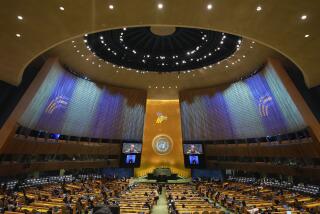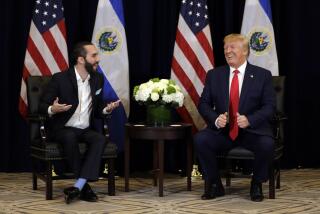Civil War Ends in El Salvador With Signing of Treaty : Peace: President Alfredo Cristiani and 10 guerrilla leaders take part in the ceremony that mixes tears and handshakes. The U.N. will supervise disarmament.
- Share via
MEXICO CITY — The president of El Salvador and 10 leftist guerrilla leaders shook hands in a tearful encounter Thursday as they signed a treaty ending their tiny Central American nation’s 12-year conflict, the Western Hemisphere’s bloodiest legacy of the Cold War.
“The conflict is behind us,” President Alfredo Cristiani declared at the historic ceremony climaxing 21 months of U.N.-mediated peace talks. “Starting today, we can truly say that Salvadoran democracy belongs to all of us.”
The accord, hailed by U.N. Secretary General Boutros Boutros-Ghali as “a revolution achieved through negotiations,” sets in motion a formal U.N.-supervised cease-fire starting Feb. 1 and ending with the disarmament of Latin America’s most disciplined rebel force by Halloween.
While diluting the extraordinary power of the armed forces in Salvadoran life, it provides full political freedoms and a host of security and welfare guarantees for the demobilized rebels of the Farabundo Marti National Liberation Front.
Guerrilla commanders declared triumphantly that the treaty’s terms vindicated their Marxist-inspired insurgency, which cost an estimated 75,000 lives, wrecked the country’s economy and civilian institutions and displaced one-fifth of its 5 million people.
“The FMLN opens its fist and extends a hand of friendship to those against whom we have fought, as is appropriate in an outcome without winners or losers, with the firm purpose of letting the reunification of our country begin,” said Schafik Handal, the chief rebel negotiator.
With a glance toward Secretary of State James A. Baker III, he added: “We also extend a hand to the United States government in search of a new relationship based on dignity and cooperation.”
Baker, representing a nation that spent $4 billion to try to defeat the rebels, called the treaty “an occasion for celebration.” American officials said that Baker, who traveled to El Salvador afterward, came to “make clear to all parties” that Washington backs the accord and will “remain engaged” in the peace process.
Washington is also asking the European Community, Canada, Japan and major Latin American nations to help it provide the estimated $1.8 billion that it estimates is needed to rebuild El Salvador’s war-torn economy. Japan has already agreed to cooperate.
The peace ceremony took place in the chilly amphitheater of a 207-year-old Spanish colonial castle on a hilltop in Chapultepec Park, giving the 10 presidents and prime ministers who attended a panoramic view of Mexico City’s smog-shrouded skyline.
Seated at parallel tables and facing each other across a riotously colorful bed of pansies, six Salvadoran government negotiators and the 10 rebel leaders signed the 121-page accord, the final details of which were hammered out Tuesday at U.N. headquarters in New York.
Cristiani, who resisted strong pressure from the right-wing Nationalist Republican Alliance to join two decisive rounds of New York talks, announced before arriving here that he would not sign the agreement. He took a seat on the dais with other heads of state overlooking the rebel and government negotiators.
But after all three leather-bound copies of the accord had been passed around the negotiators’ tables, they were carried up to Cristiani, who added his signature. Two hundred dignitaries in the room applauded with astonishment.
In a blunt admission of his country’s undemocratic history, Cristiani said that El Salvador lacked “the spaces and mechanisms necessary for the free play of ideas, the absence of a true democratic way of life.
“What we are beginning to do now,” he added, “is not the establishment of a pre-existing peace but the inauguration of an authentic peace based on social, political and ideological harmony . . . without any kind of exclusions.”
Then the 44-year-old president did something he had never done, not even during his rare interventions in peace talks. He stepped down from the dais and held out his hand to the guerrillas, who stood respectfully, some of them moved to tears.
Handal, a white-bearded Communist who was one of the FMLN’s five top military commanders, moved to put an arm around Cristiani, but the president quickly stepped away. But an instant later, coming face to face with guerrilla political leader Ana Guadalupe Martinez, Cristiani was overcome by emotion. Tears welled in his eyes and streamed down his face.
It was an extraordinary scene of reconciliation between the polar extremes of a nation known for its immense gap between rich and poor and the viciousness with which its citizens kill each other.
The Salvadoran conflict exploded after a rightist backlash to the ouster of a military dictator by reformist army officers in October, 1979. With help from Fidel Castro’s Cuba and the Sandinista revolutionaries who had seized power in Nicaragua that year, Salvadoran leftists formed a guerrilla force that grew to 8,000 fighters and resisted defeat by a government army swollen to four times its size by U.S. aid.
With the collapse of worldwide communism, the defeat of the Sandinistas in a 1990 election and the decline of Cuba as an international revolutionary force, the FMLN saw its chances of seizing power slip away.
The United States, meanwhile, abandoned its view of the guerrillas as a Soviet-backed threat to its influence in Latin America. And it lost patience with the Salvadoran army’s atrocities, such as the murders of six Jesuit priests during a rebel offensive in 1989. Thanks in part to a peace effort launched by then-President Oscar Arias Sanchez of Costa Rica, pressure for negotiations grew.
Thursday’s ceremony was a celebration of the Latin American statesmanship that nudged the stubborn conflict to a close. On hand were the presidents of all six Central American nations and the leaders of four countries with influential backstage roles in the Salvadoran talks--Mexico, Colombia, Venezuela and Spain.
Also in the audience was Arias, who helped bring about the elections that ended the eight-year war between Sandinistas and U.S.-backed rebels in Nicaragua. He chatted amiably with Daniel Ortega, the Sandinista president who was resoundingly defeated in that vote.
“The triumph of El Salvador is a triumph for the region,” declared Mexican President Carlos Salinas de Gortari. “It is a triumph of the weapons of reason over the weapons of destruction.”
Baker praised Mexico’s “extraordinarily significant” contribution to the Salvadoran accord by playing host to most of the talks. U.S. officials said they hope peace would give impetus to similar negotiations under way between the government and rebels in neighboring Guatemala, which has been at a lower level of turmoil for three decades.
One key figure absent from Thursday’s ceremony was Javier Perez de Cuellar, the U.N. secretary general who pushed the warring parties to an agreement on most of their differences last New Year’s eve, just as his term expired.
Under the New Year’s accord, the 63,175-member Salvadoran army will slash its ranks by half over a two-year period, relinquish control of public order to a new National Civil Police and allow a civilian commission to purge officers it deems to be abusive or corrupt. Land in rebel-held territory will be distributed to the guerrillas, their families and supporters now farming it.
Rebel leaders acknowledged Thursday that their insurgency had failed in its goal to crush “the power of the great lords of land and capital.” But they insisted that army reform would change the country forever.
“We’ve achieved the conditions to begin a new battle, a political battle,” guerrilla field commander Facundo Guardado told reporters. “The most important step is taking away the preponderant role of the army.”
The peace talks continued into this week over four sticking points:
* A rebel demand for a quota of officers in the new police force. The rebels abandoned that position and accepted the creation of an impartial commission to name all officers.
* A timetable for troop demobilization. The rebels agreed to gather into 50 cease-fire zones starting in February and muster out between April 30 and Oct. 31, under the supervision of 1,000 U.N. peacekeeping forces. The army will gather in 100 zones. Its reduction will start with the abolition of its five counterinsurgency battalions, one a month beginning July 30.
* The details of land distribution. The government agreed to compensate former owners for land given to the rebels but said that it will relocate the occupants from any land that a former owner is unwilling to give up.
* The scope of an amnesty. The government insists that an amnesty cover all atrocities committed during the war, even the slayings of the Jesuit priests. The FMLN says it should apply only to its guerrillas who disarm. The issue is still unresolved.
More to Read
Sign up for Essential California
The most important California stories and recommendations in your inbox every morning.
You may occasionally receive promotional content from the Los Angeles Times.










